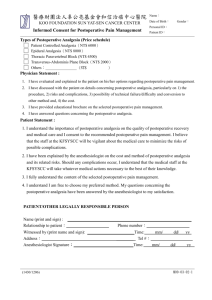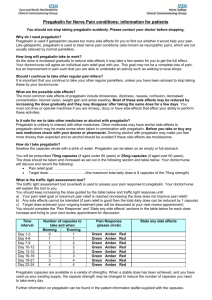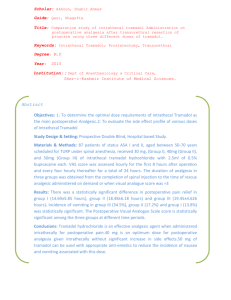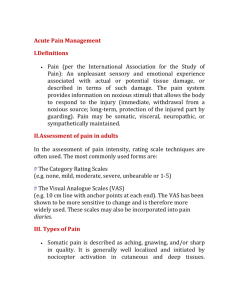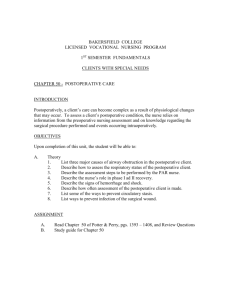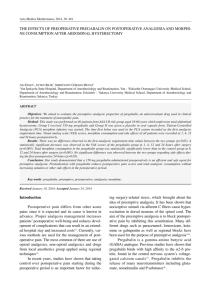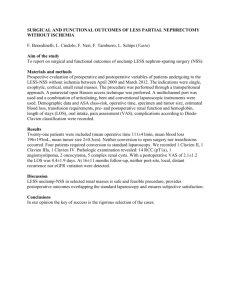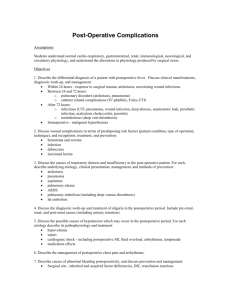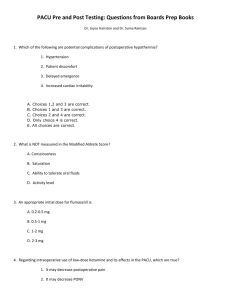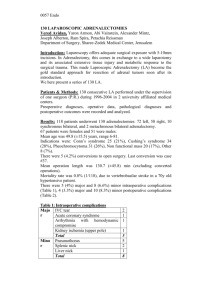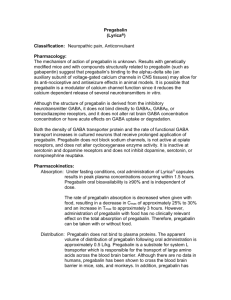efficacy of pregabalin in immediate post
advertisement
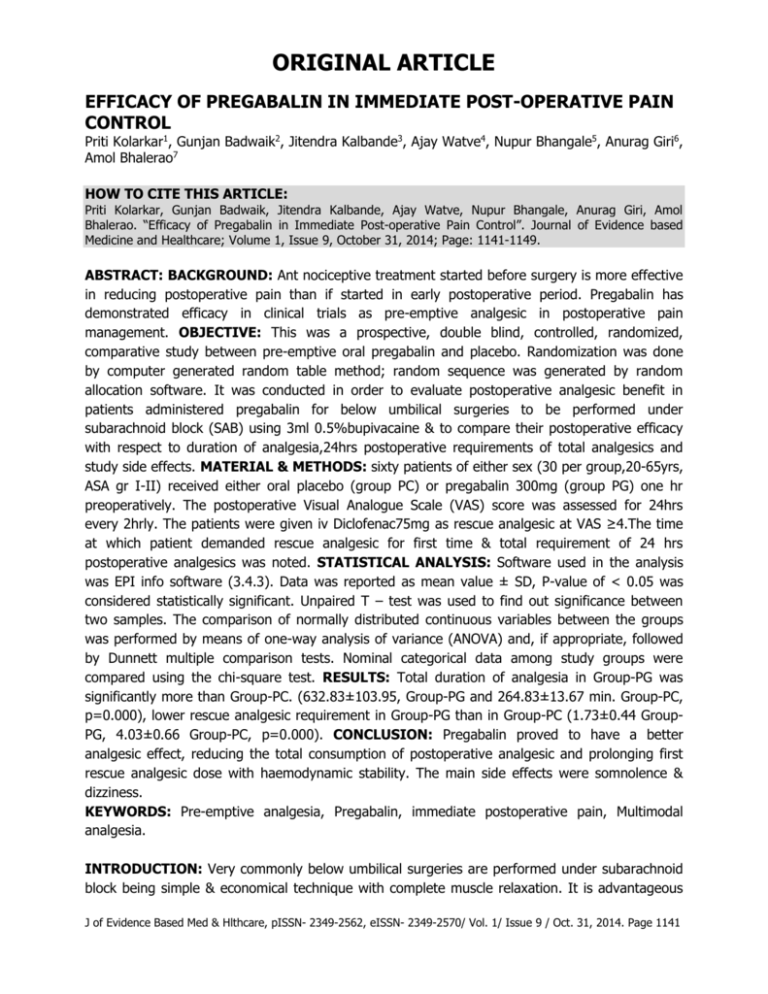
ORIGINAL ARTICLE EFFICACY OF PREGABALIN IN IMMEDIATE POST-OPERATIVE PAIN CONTROL Priti Kolarkar1, Gunjan Badwaik2, Jitendra Kalbande3, Ajay Watve4, Nupur Bhangale5, Anurag Giri6, Amol Bhalerao7 HOW TO CITE THIS ARTICLE: Priti Kolarkar, Gunjan Badwaik, Jitendra Kalbande, Ajay Watve, Nupur Bhangale, Anurag Giri, Amol Bhalerao. “Efficacy of Pregabalin in Immediate Post-operative Pain Control”. Journal of Evidence based Medicine and Healthcare; Volume 1, Issue 9, October 31, 2014; Page: 1141-1149. ABSTRACT: BACKGROUND: Ant nociceptive treatment started before surgery is more effective in reducing postoperative pain than if started in early postoperative period. Pregabalin has demonstrated efficacy in clinical trials as pre-emptive analgesic in postoperative pain management. OBJECTIVE: This was a prospective, double blind, controlled, randomized, comparative study between pre-emptive oral pregabalin and placebo. Randomization was done by computer generated random table method; random sequence was generated by random allocation software. It was conducted in order to evaluate postoperative analgesic benefit in patients administered pregabalin for below umbilical surgeries to be performed under subarachnoid block (SAB) using 3ml 0.5%bupivacaine & to compare their postoperative efficacy with respect to duration of analgesia,24hrs postoperative requirements of total analgesics and study side effects. MATERIAL & METHODS: sixty patients of either sex (30 per group,20-65yrs, ASA gr I-II) received either oral placebo (group PC) or pregabalin 300mg (group PG) one hr preoperatively. The postoperative Visual Analogue Scale (VAS) score was assessed for 24hrs every 2hrly. The patients were given iv Diclofenac75mg as rescue analgesic at VAS ≥4.The time at which patient demanded rescue analgesic for first time & total requirement of 24 hrs postoperative analgesics was noted. STATISTICAL ANALYSIS: Software used in the analysis was EPI info software (3.4.3). Data was reported as mean value ± SD, P-value of < 0.05 was considered statistically significant. Unpaired T – test was used to find out significance between two samples. The comparison of normally distributed continuous variables between the groups was performed by means of one-way analysis of variance (ANOVA) and, if appropriate, followed by Dunnett multiple comparison tests. Nominal categorical data among study groups were compared using the chi-square test. RESULTS: Total duration of analgesia in Group-PG was significantly more than Group-PC. (632.83±103.95, Group-PG and 264.83±13.67 min. Group-PC, p=0.000), lower rescue analgesic requirement in Group-PG than in Group-PC (1.73±0.44 GroupPG, 4.03±0.66 Group-PC, p=0.000). CONCLUSION: Pregabalin proved to have a better analgesic effect, reducing the total consumption of postoperative analgesic and prolonging first rescue analgesic dose with haemodynamic stability. The main side effects were somnolence & dizziness. KEYWORDS: Pre-emptive analgesia, Pregabalin, immediate postoperative pain, Multimodal analgesia. INTRODUCTION: Very commonly below umbilical surgeries are performed under subarachnoid block being simple & economical technique with complete muscle relaxation. It is advantageous J of Evidence Based Med & Hlthcare, pISSN- 2349-2562, eISSN- 2349-2570/ Vol. 1/ Issue 9 / Oct. 31, 2014. Page 1141 ORIGINAL ARTICLE due to high efficacy with less drug doses and less chances of aspiration pneumonitis. Due to its limitations in the form of lesser control of block height & limited duration of analgesia researchers have used battery of drugs intrathecally like vasoconstrictors, (epinephrine) opioids, (fentanyl, buprenorphine) benzodiazepines, (midazolam) ketamine and many others as adjuvant to local anaesthetics to prolong the duration of sensory block & achieve longer perioperative analgesia.1 But each of this adjuvant has certain limitations of their own hence search for better options for acute postoperative analgesia research is still continuing. The concepts like preemptive and multimodal analgesia could be the fruitful results of it. Poorly controlled postoperative results in harmful acute effects (adverse physiologic response) & chronic effects (delayed recovery) and chronic pain syndrome.2 Provision of effective pain relief is a prerequisite accelerated convalescence. Previously the drugs used for acute & chronic pain were categorically different. Opioids, NSAIDS & local anaesthetics were tools for dealing with acute pain and tricyclic antidepressants (TCAs) were used for chronic neuropathic conditions. Pregabalin is a structural analogue of the inhibitory neurotransmitter γ-amino butyric acid but it is not functionally related to it3. Like its predecessor gabapentin it binds to the α-2-δ subunit of voltage-gated calcium channels reducing the release of several excitatory neurotransmitters and blocking the development of hyprealgesia and central sensitization.4,5 Pregabalin has anticonvulsant antihyperalgesic and anxiolytic properties similar to gabapentin, but it has a more favorable pharmacokinetic profile including dose-independent absorption.6,7 It is also several times more potent than gabapentin while producing fewer adverse effects.3 Recently it has been introduced as an adjunct in the multimodal management of postoperative analgesia8.Recently the role as oral pre-emptive analgesic of pregabalin9-11 for postoperative pain relief has been reviewed. With the concept of pre-emptive analgesia for control of acute postoperative pain our primary aim was to evaluate postoperative analgesic benefit in patients administered pregabalin or placebo as oral premedication for below umbilical surgeries performed under SAB & to study its postoperative efficacy with respect to duration of analgesia, total postoperative requirement of analgesics and to study side effects, if any, attributable to pregabalin. MATERIALS AND METHODS: In this double-blind, randomized, controlled clinical trial, after approval from institutional ethical committee, and with written informed consent, sixty, American Society of Anesthesiologists(ASA) class I or II patients of either sex, between 20-65yrs, undergoing below umbilical surgeries, with estimated surgery duration of 90-120 mins. To be performed under SAB were recruited. Patients with positive history of pregabalin or antihypertensive consumption, history of seizure, psychiatric disorders, drug abuse, known liver and renal disease, chronic pain syndrome, intake of analgesic drugs during last 24hrs, known sensitivity to bupivacaine, pregabalin, patient refusal, contraindication to SAB, pregnancy were excluded from the study. A thorough clinical assessment and routine investigations like hemoglobin, TLC, DLC, Urine examination, x-ray chest, electrocardiogram and other specific investigations were done. Patients were assigned to one of the two treatment groups of 30 each in parallel, double blind, randomized manner with the help of a computer-generated table of random numbers. J of Evidence Based Med & Hlthcare, pISSN- 2349-2562, eISSN- 2349-2570/ Vol. 1/ Issue 9 / Oct. 31, 2014. Page 1142 ORIGINAL ARTICLE Patients in treatment group were given Tab pregabalin300mg (Group-PG) and those in control group (Group-PC) received placebo 1hr preoperative by a staff nurse who was not involved in the study. After placement of standard noninvasive monitoring devices like NIBP, pulse oximetry and ECG, (baseline values were noted) preloading with 10ml/kg RL containing 50mg ranitidine was done. SAB was performed using 3ml 0.5% hyperbaric bupivacaine & surgery was performed after confirmation of successful blockade with proper height of analgesia. Fluid administration was continued intra operatively. Hypotension, fall in mean arterial pressure by 20% of baseline was treated by fluid bolus & intravenous (iv) ephedrine 6mg. Bradycardia, fall in heart rate by 20% of baseline was treated with iv atropine0.6mg. No analgesic or sedative was given intra operatively. The anesthesiologists who was blinded to the patient group, assessed pain postoperatively by VAS scale (a horizontal 0-10cm straight line with left end of the line expressing no pain and the right end-worst pain) immediate postoperatively and every 2hrs thereafter for 24hrs, which was explained to the patient preoperatively. Any patient with VAS score≥4, during above period received IV diclofenac 75mg. Time since SAB to first dose of analgesic and total requirement of analgesic in first 24hrs in each group, along with any side effects like dizziness, somnolescence, diplopia, vomiting, confusion, nausea, urinary retention were recorded. Ramsay sedation was observed during immediate postoperative period till 24 hours using Ramsay sedation score from 1 to 6. Patients with sedation scale ≥4 were considered as sedated. RESULTS: STATISTICAL ANALYSIS: Sample size was calculated by using EPI info software (3.4.3) in consultation with statistician, minimum sample size was calculated 30 in each group, considering confidence interval of 95%, power 90 % with 1:1 Unpaired T – test was used to find out significance between two samples. Data was reported as mean value ±SD =. P-value of < 0.05 was considered statistically significant for total duration of analgesia, time to first rescue analgesia, comparison of VAS. Results are expressed as the number, percentages, mean ± SD as appropriate. The comparison of normally distributed continuous variables between the groups was performed by means of one-way analysis of variance (ANOVA) and, if appropriate, followed by Dunnett multiple comparison tests. Nominal categorical data among study groups were compared using the chisquare test. DEMOGRAPHIC COMPARISON: Sixty patients, thirty in each group, were included in this study and analyzed. The groups were comparable with respect to demographic characteristics like age, weight, physical status, and duration of surgery (Table 1) The types of surgery conducted were also similar. (Table 2) POST-OPERATIVE ANALGESIA: The total postoperative analgesia duration (time from spinal analgesia to first dose of analgesic) was 264.83±13.67 min. in Group-PC and 632.83±103.95 min. in Group-PG. (Table 3) Statistically highly significant variation was found in mean total duration of analgesia in both the groups (p-value=0.000) The total requirement of analgesic in J of Evidence Based Med & Hlthcare, pISSN- 2349-2562, eISSN- 2349-2570/ Vol. 1/ Issue 9 / Oct. 31, 2014. Page 1143 ORIGINAL ARTICLE first 24h was 4.03±0.66 in Group-PC and 1.73±0.44 in Group-PG (Table 4). The difference was statistically significant. Ramsay Sedation score was significant up to 16 hours in PG group and remained nonsignificant from 16 to 24 hours.(Table 5). This was statistically significant when compared to control group. Statistically significant dizziness and somnolence was observed in PG group in 4 patients each (Table 6). No episodes of bradycardia and hypotension in control and PG gr. (Table 6) were observed. DISCUSSION: The cardinal signs of neuropathic pain, Allodynia and Hyperalgesia, are also found to be present in acute pain following trauma and surgery, hence both types of pain have similar pathophysiology, and Multimodal treatment of postoperative pain using adjuncts such as gabapentinoids is becoming more common. Sensitization of neurons in dorsal horn, a mechanism in neuropathic pain is present in acute pain models also.12 Voltage gated calcium channels play a large role in the increase of nociceptive drive due to neuropathic as well as acute inflammatory pain. Pregabalin binds to α2-δ subunit of calcium channel of the primary afferent nociceptors, inhibiting the release of excitatory transmitters. This prevents the mechanism of central sensitization when the drug is given in the form of a presurgical dose. Pregabalin has anti-hyperalgesic properties and appear to reduce the hyper excitability of dorsal horn neurons that is induced by tissue damage.13,14 We have used pregabalin in the dose of 300mg which is similar to previous studies15,16 and also as per meta-analysis of gabapentinoid.17 More than 300 mg dose of pregabalin may lead to more side effects like dizziness and somnolence. Administration of pregabalin 1 hr prior to surgery appeared in order to attain maximal plasma concentration at the time of surgical stimuli, as both the drugs get rapidly absorbed with peak within 1-2 hr18,19 The mean duration of postoperative analgesia in control group and pregabalin group was 264.83±13.67 minutes and 632.83±103.95 minutes respectively, showing statistically significant increase in postoperative analgesia duration. (Table 3) Two comparative studies (gabapentin v/s pregabalin) using single oral pre-emptive drug for infraumbilical surgeries under SAB, for evaluation of their comparative efficacy in terms of a cute postoperative analgesic benefits with rescue analgesic as diclofenac have shown similar results to our study. V. Saraswat et al,10 concluded that the total postoperative analgesic time was 8.98hrs in gabapentin group though less than pregabalin group (14.17hrs), both being effective in prolongation of post-spinal analgesia. Vishal Arora et al,19 reported that the total postoperative analgesic duration was 6.14 ± 2.07hrs in gabapentin group,7.31 ± 1.43hrs in pregabalin group and 4.13 ± 1.00hrs in placebo group,(p<0.001 in both the studies) with reduced rescue analgesic requirements. Sahu S. etal9 concluded that a 300mg dose of pregabalin in two divided doses before below umbilical surgeries under spinal anaesthesia, provides better pain control than placebo and reduces demand for rescue analgesics, since, the time of first analgesic requirement was 4.0±0.0 hrs in placebo & 7.60±0.95 hrs in pregabalin group which was definitely more than duration of spinal anesthesia suggesting prolongation of spinal anesthesia. J of Evidence Based Med & Hlthcare, pISSN- 2349-2562, eISSN- 2349-2570/ Vol. 1/ Issue 9 / Oct. 31, 2014. Page 1144 ORIGINAL ARTICLE Kohli Met al15 observed that time required for first rescue analgesia was 131.38±5.15 minutes in control gr, 176.38±4.80 minutes in pregabalin 150 gm gr and 202.42±6.77 minutes in pregabalin 300 gm gr (p-value <0.05) in hysterectomy under spinal anaesthesia and hence they concluded that oral pregabalin is useful in immediate postoperative analgesia which is similar to our study. The mean requirement of rescue analgesia doses in all three groups are (table no 4): Control group 4.03±0.66 and Pregabalin group 1.73±0.44, highly significant less doses requirement when compared with control group (p= 0.00). Sahu Set al9 found that there was a mean reduction in total number of rescue I.V. tramadol 1mg/kg doses in PG gr (1.94±0.28) as compared to control gr (3.38±0.48). Saraswat V et al10 observed that the mean requirement of I.M. diclofenac 1mg/kg doses in PG gr (0.9) was less compared to gabapentin gr (1) in 24 hrs postoperatively (p>0.05). PG group has more sedation throughout the postoperative period than control group. Mean Ramsay sedation score were 1 in control gr (Table 5) throughout the postoperative period while mean sedation scores at 2, 6, 8, 12, 16 hrs in PG were (3.46, 3, 3, 2.5, 2.0) which were statistically significant (p<0.05) (Table 5). In Pregabalin group, 4 patients each experienced dizziness and somnolence. (Table 6) The incidence reported in present study appears to be more or less similar to earlier studies.10,15,17,19 These side effects are usually not disabling and antianxiety effect appears to be beneficial. This did not seem to affect the outcome of the patients. As per our standard monitoring care with regular monitoring of respiration and pulse oximetry for first 24 hours, no patients in this study had respiratory depression or desaturation. We did not know whether somnolence and dizziness affected the patients’ ability to ambulate, but it may have caused patients to report lower pain scores, since these patients may have reduced ability or reduced motivation to report pain. However, we specifically assessed movement pain by asking them to move from lying to sitting, which should limit the amount of bias secondary to this side effect. Nausea and vomiting in control group could be because of more number of NSAIDs (I.V. Diclofenac) required in this group. Various studies have successfully demonstrated the efficacy of pregabalin in reducing acute postsurgical pain. Ruben et al20 observed that pre-emptive pregabalin significantly reduced postoperative VAS scores and rescue analgesic requirements in patients undergoing posterior spinal fusion surgery with no adverse effects on heart rate, blood pressure and respiration. Mathiesen et al16observed 50% reduction in postoperative pain scores and no negative hemodynamic effects with single dose pregabalin administration 1 hr preoperatively in total hip arthrtoplasty cases. Agarwal et al11 used single dose 150 mg 0f pregabalin one hr preoperatively in laparoscopic cholecystectomy, also observed reduced rescue analgesic consumption postoperatively with stable hemodynamics. This study design, has certain limitations, in that, single dose of pregabalin has been used. The half-life of pregabalin is 9-12hrs which may have resulted with decreased effect over time and conclusion about the optimal dose and duration of the treatment cannot be made for these particular types of surgeries. Since additional pre-emptive regional analgesia technique was not included in our study, which would have been beneficial to the patients and due to significant variations in the degree J of Evidence Based Med & Hlthcare, pISSN- 2349-2562, eISSN- 2349-2570/ Vol. 1/ Issue 9 / Oct. 31, 2014. Page 1145 ORIGINAL ARTICLE of postoperative pain among patients undergoing similar surgical procedures, it would be helpful to identify the patients with most likely severe postoperative pain. This should allow more aggressive analgesic therapy in such type of patients. Conclusion Pregabalin, given preoperatively prolongs the total postoperative analgesia duration, reduce analgesic requirements without significant side effects. Pregabalin can be an effective tool in the armamentarium of anesthesiologist in the treatment of acute postoperative pain. It can be a good alternative in the multimodal therapy of acute post-operative analgesia, if not as sole analgesic. REFERENCES: 1. Forster JG, Rosenberg PH. Clinically useful adjuvants in Regional anaesthesia. Curr opin Anaesthesiol. 2003 Oct; 16 (5): 477-86. 2. Macrae WA. Chronic pain after surgery. Br J Anaesth. 2001; 88-9. 3. Ben-Menachem E. Pregabalin pharmacology and its relevance to clinical practice. Epilepsi. 2004; 45 (suppl. 6): 13-8. 4. Shneker BF, McAuley JW. Pregabalin: A New Neuromodulator with broad therapeutic indications. Ann Pharmacother. 2005; 39: 2029-37. 5. Chizh BH, Gohring M, Troster A, Quartey GK, Schmelz M, Koppert W. Effects of oral pregabalin and operation on pain and central sensitization in the electrical hyperalgesia model in human volunteers. Br J Anaesth. 2007; 98: 246-54. 6. Guay DR. Pregabalin in neuropathic pain: A more ‘pharmacetically elegant ‘gabapentin? Am J Geriatr Pharmacother. 2005; 3: 274-87. 7. Frampton JE, Foster RH. Pregabalin: In the treatment of post herpetic neuralgia. Drugs2005; 65: 111-8; 9-20. 8. Gilron I. Gabapentin and pregabalin for chronic neuropathic and early postsurgical pain: Current evidence and future directions. Curr Opin Anaesthesiol 2007; 20: 456-72. 9. Sahu S, Sachan S, Verma A, Pandey HD, Chitra. Evaluation of Pregabalin for attenuation of postoperative pain in below umbilical surgeries under spinal anaesthesia. Anaesth Clin Pharmacol. 2010; 26 (2): 167-71. 10. Saraswat V, Arora V. Preemptive Gabapentin vs Pregabalin for Acute Postoperative Pain after Surgery under Spinal Anaesthesia. Ind J of Anaesth. 2008; 52 (6): 829-834. 11. Agarwal A, Gautam S, Gupta D, Agarwal S, Singh PK, Singh U. Evaluation of a single preoperative dose of pregabalin for attenuation of postoperative pain after laparoscopic cholecystectomy. Br J Anaesth. 2008 Nov; 101 (5): 700-4. 12. Lascelles BDX, Waterman AE, Cripps PJ, et al, Central sensitization as a result of surgical pain. Investigation of the effect of preemptive value of pethidine for ovaro-hysterotomy in rats. Pain 1995; 62; 201-2. 13. Ben-Menachem E. Pregabalin pharmacology and its relevance to clinical practice. Epilepsia1 2004; 45: 13-8. 14. Martin DJ, McClelland D, Herd MB, etal. Gabapentin-mediated inhibition of voltage-activated Ca2+ channel currents in cultured sensory neurons is dependent on cultured conditions and channel subunit expression. Neuropharmacology 2002; 42: 352-66. J of Evidence Based Med & Hlthcare, pISSN- 2349-2562, eISSN- 2349-2570/ Vol. 1/ Issue 9 / Oct. 31, 2014. Page 1146 ORIGINAL ARTICLE 15. Kohli M, Murali T, Gupta R, Khan P, Bogra J. Optimization of Subarachnoid Block by Oral Pregabalin for Hysterectomy. J Anaesthesiol Clin Pharmacol. 2011 Jan; 27 (1): 101–105. 16. Mathiesen O, Jacobsen LS, Holm HE, Randall S, Adamiec-Malmstroem L, Graungaard BK, Holst PE, Hilsted KL, Dahl JB. Pregabalin and dexamethasone for post-operative pain control: randomized controlled study in hip arthroplasty.Br J Anaesth. 2008 Oct; 101 (4): 535-41. 17. Tippana EM, Hamunen K, Kontinen VK, Kalso E. Do surgical patients benefit from perioperative gabapentin/pregabalin? A systematic review of efficacy and safety. Anesth Analg. 2007; 104 (6): 1545-56. 18. Dollery CT, Davies DS, Draffan GH, etal. Clinical pharmacology and pharmacokinetics of oral clonidine. Clin Pharmacol Ther 1975; 19: 11-17. 19. Arora V, Yajnik S, Rastogi S, Bhandari R. Evaluation of Oral Gabapentin versus oral Pregabalin in Acute Postoperative Pain in Surgeries under Spinal Anaesthesia. Indian Journal of Pain. 2009; 23: 401-6. 20. Ruben SS, Bhuvanendran a et al. Analgesic efficacy of colecoxib, pregabalin and their combination for spinal fusion surgery. Anesth Analg 2006; 103; 1271-7. PC PG P-value Mean SD Mean SD Age (yrs) 39.83 12.33 38.86 14.87 0.45 NS, p>0.05 Gender M/ F 21:9 23:7 0.29 NS, p>0.05 Weight (kg) 54.70 6.56 55.73 8.46 0.28 NS, p>0.05 Height (cms) 157.36 5.47 160.43 6.35 0.32 NS, p>0.05 TABLE 1: Comparison of demographic characteristics of patients Type of surgeries PC PG א2-value Inguinal Hernia 9(30%) 10(33.33%) Fracture Tibia 3(10%) 1(3.33%) Debridement 2(6.67%) 2(6.67%) Amputation 5(16.67%) 3(10%) 3.71 Varicocele 4(13.33%) 4(13.33%) p=0.99 NS, p>0.05 Appendectomy 2(6.67%) 1(3.33%) Skin Grafting 3(10%) 6(20%) Para umbilical hernia 2(6.67%) 3(10%) Total 30(100%) 30(100%) TABLE 2: Distribution of patients according to type of surgeries in three groups. J of Evidence Based Med & Hlthcare, pISSN- 2349-2562, eISSN- 2349-2570/ Vol. 1/ Issue 9 / Oct. 31, 2014. Page 1147 ORIGINAL ARTICLE PC PG P-value Mean SD Mean SD Total duration of 264.83 632.83 0.000 13.67 103.95 analgesia in minutes Min Min S, p <0.05 TABLE 3: Comparison of total duration of analgesia in three groups. Descriptive Statistics PC Mean SD PG Mean SD P-value Total no. of 0.000 4.03 0.66 1.73 0.44 dose of analgesia S, p<0.05 TABLE 4: Comparison of total dose of analgesia in three groups in 24 hrs post-operavtive. Descriptive Statistics Ramsay Std. Std. Group N Mean Minimum Maximum Score Deviation Error PC 30 1.00 0.00 0.00 1.00 1.00 2 hrs PG 30 3.46 0.68 0.12 2.00 4.00 PC 30 1.00 0.00 0.00 1.00 1.00 6 hrs PG 30 3.00 0.68 0.12 2.00 4.00 PC 30 1.00 0.00 0.00 1.00 1.00 8 hrs PG 30 3.00 0.98 0.17 1.00 4.00 PC 30 1.00 0.00 0.00 1.00 1.00 12 hrs PG 30 2.50 0.76 0.13 1.00 3.00 PC 30 1.00 0.00 0.00 1.00 1.00 16 hrs PG 30 2.00 0.76 0.13 1.00 3.00 PC 30 1.00 0.00 0.00 1.00 1.00 24 hrs PG 30 1.70 0.52 0.09 1.00 3.00 TABLE 5: Comparison of Ramsay Sedation Score in three groups postoperatively. Descriptive Statistics Side effects Bradycardia Hypotension No side effects Dizziness Somnolence PC 0 (0.00%) 0 (0.00%) 25 (83.33%) 0 (0.00%) 0 (0.00%) PG 0 (0.00%) 0 (0.00%) 20 (66.67%) 4 (13.33%) 4 (13.33%) א2-value 22.57 p=0.004 S, p<0.05 J of Evidence Based Med & Hlthcare, pISSN- 2349-2562, eISSN- 2349-2570/ Vol. 1/ Issue 9 / Oct. 31, 2014. Page 1148 ORIGINAL ARTICLE Others/Nausea, Vomiting/urine retention 5 2 (16.67%) (6.67%) 30 30 Total (100%) (100%) TABLE 6: Comparison of distribution of side effects in three groups. AUTHORS: 1. Priti Kolarkar 2. Gunjan Badwaik 3. Jitendra Kalbande 4. Ajay Watve 5. Nupur Bhangale 6. Anurag Giri 7. Amol Bhalerao PARTICULARS OF CONTRIBUTORS: 1. Associate Professor, Department of Anaesthesia, NKP Salve Institute of Medical Sciences, Nagpur. 2. Assistant Professor, Department of Anaesthesia, NKP Salve Institute of Medical Sciences, Nagpur. 3. Senior Resident, Department of Anaesthesia, NKP Salve Institute of Medical Sciences, Nagpur. 4. Senior Resident, Department of Anaesthesia, NKP Salve Institute of Medical Sciences, Nagpur. 5. Junior Resident, Department of Anaesthesia, NKP Salve Institute of Medical Sciences, Nagpur. 6. Junior Resident, Department of Anaesthesia, NKP Salve Institute of Medical Sciences, Nagpur. 7. Junior Resident, Department of Anaesthesia, NKP Salve Institute of Medical Sciences, Nagpur. NAME ADDRESS EMAIL ID OF THE CORRESPONDING AUTHOR: Dr. Priti Kolarkar, # 287, Ramnagar, Nagpur. E-mail: pritik8@gmail.com Date Date Date Date of of of of Submission: 13/10/2014. Peer Review: 14/10/2014. Acceptance: 17/10/2014. Publishing: 20/10/2014. J of Evidence Based Med & Hlthcare, pISSN- 2349-2562, eISSN- 2349-2570/ Vol. 1/ Issue 9 / Oct. 31, 2014. Page 1149
